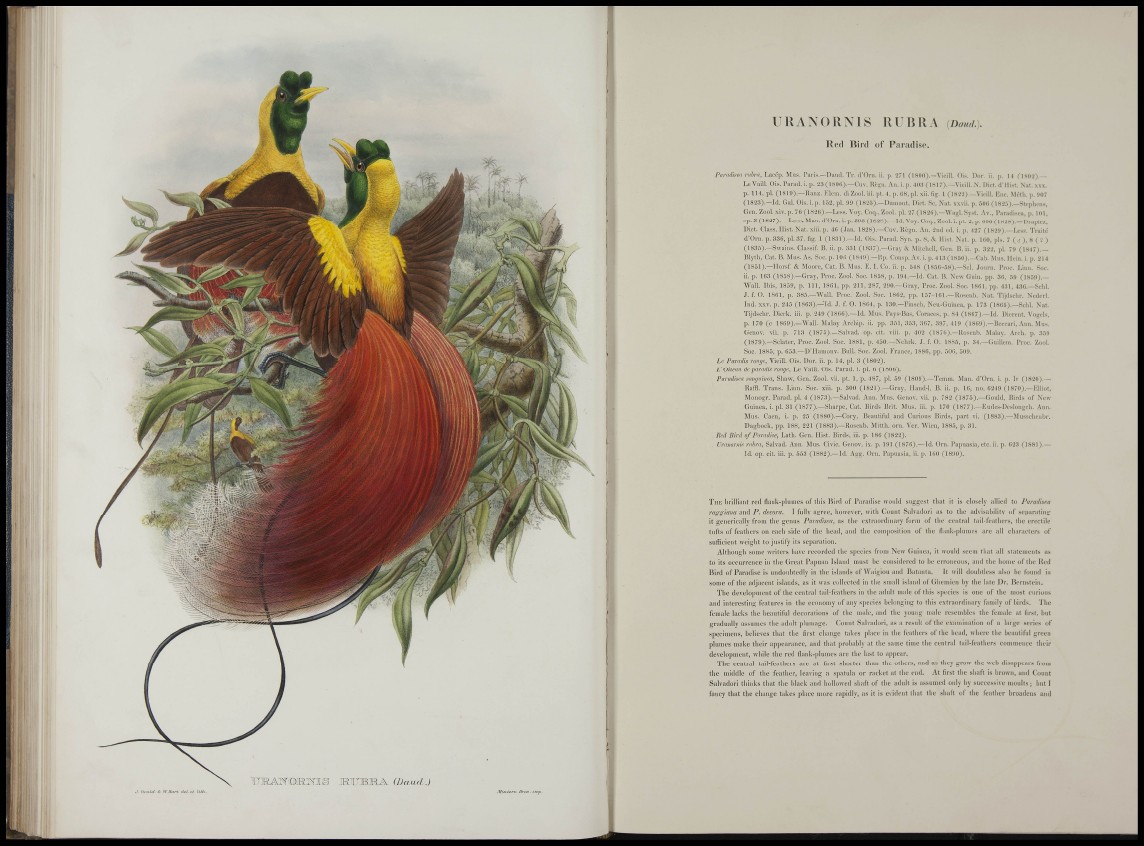
f
" i
I V
Il
il
ÌH fi.
1 f i
l i
li -h
b i t i i ^ i
JìjHljif
y i i . i i l l i í
J Oi rUd i- ivn{u< dei. ci Ulh . .Xfint^rn Bros. imp.
U R A N O R N I S RUIÌRA (W.).
Red Bird of Paradise.
Pcirndisea ruhro, Lacép. Mus. Puris.—Daucl. Tr. (VOi-ii. ii. p. 271 (1 8no).—Vk'ill. Ois. Dor. ii. j). 1 í ris(t2). —
LeA'alll, Oís. Parad, i. p. 2:1 (ISOli).—Cuv. Resu. Au. i. p. 4():i (1H17).—Vicill. Diet, d' l l ist . Nat..\xií.
p. ll'l, pl. (1819).—Rai iz. Klem. di Zool. iii. p t I, p. (iS. ])1. xii. fig. 1 (1H22).—Vii'ill. ICiic. Mc'lli. p. !KI7
(1823).—Id. Gal. OÍS. i. p. 162, pl. üil (1825).—Diiinoiit, Diet. Sc. Nat . xxvii. p. 51l(i (182.')).—Su-phc-ns,
Gen. Zool .xiv.p. 76 (1S2(!).—Less. Voy. Cnq.,Zool. pl. 27 (182i;).—Wagl. Syst. Av., I'aradisea, p. Kll,
sp. 3 (1827) .—Less. Man. d'Orn. i. p. 3!Ki (1828) .—Id. Voy. Coq,, Zool. i. j)!. 2, p. IHiO (1828; .—Drapiez,
Diet. Class. Hist. Nat. xiii. p. 4(i (Jan. 1828).—Cuv. Uegii. An. 2nd ed. i. p. 427 (182ÍI).—U's?. Traite
d'Orn. p. 33(1, pl. 37. fig. 1 (1S31).—Id. Ois. I'arad. Syn. p. 8, it Hist. Nat. p. l(i», pis. 7 (<j ) , 8 ( S ;
(183,')).—Swains. Classif. B. ii. p. 331 (1837).—Gray & Mitchell, Gen. Ti. ii. p. 322, pl. 71) (1817).—
Blyth, Cat. B. Mus. As. Soc. p. Klli (184!))—Bp. Consp. Av. i. p. 413 (IB. ' iO).-Cab. Mus. Ilein. i. p. 214
(1851).—llorsf & Moore, Cat. B. Mus. E. I. Co. ii. p. 548 (185(i-58).—Scl. Journ. I'roe. Linn. Soc.
ii. p. 163 (1858).—Gray, Proe. Zool. Soe. 1858, p. 194.—Id. Cat. H. New Guin. pp. 36, 59 (1859).—
Wall. Ibis, 1859, p. I l l , 1801, pp. 211, 2S7, 290.—Gray, Proc. Zool. Soc. 1861, pp. 431, 436.—Scbl.
J. f. O. 1861, p. 385.—Wall. Proc. Zool. Soc. 1862, pp. 157-161.—llosenb. Nat. Tijdschr. Nederl.
Ind. XXY. p. 245 (1S6.S).—Id. .T. f. O. 1864, p. 130.—Finsch, Neu-Guinca, p. 173 (1865).-Scld. Nat.
Tijdschr. Dierk. iii. p. 249 (1866).—Id. Mus. Pays-Bas, Coraces, p. 84 (1867).—Id. Diercnt. Voxels,
p. 170 (c 1869).—Wall. Malay Archip. ii. pp. 351, 353, 367, 397, 419 (1869).—Bcccari, Ann. Mns.
Genov. vii. p. 713 (1875).—Salvad, op. cit. liii. p. 402 (1876).—Iloseub. Malay. Arch. p. 359
(1879).—Selater, Proc. Zool. Soe. 1881, p. 430.—Nehrk. J. f. 0 . I8S5, p. 34.—Guillem. Proc. Zool.
Soc, 1885, p. 653.—U'llamouv. Bull. Soc. Zool. France, 1886, pp. 506, 509.
Le Paraiis rouge, Vieill. Ois. Dor. ii. p. 14, pl. 3 (1802).
VOisemi He ¡Kiradis rouge, Le Vaill. Ois. Parad, i. pl. 6 (1S06).
Paradkea sanguínea, Shaw, Gen. Zool. vii. pt. 1, p. 487, pl. 59 (1809).—Temm. Man. d'Orn. i. p. Iv (1820).—
Raffl. Trans. Linn. Soe. xiii. p. 300 (1821).—Gray, IIand-1. B. ii. p. 16, no. 6249 (1870).—Elliot,
Mouogr. Parad, pl. 4 (1873).—Salvad. Ann. Mils. Genov. vii. p. 782 (1875).—Gould, Birds of New
Guinea, i. pl. 31 (1877).—Sharpc, Cat. Birds Brit. Mus. iii. p. 170 (1877).—Eudcs-Dcslongch. Ann.
Mns. Caen, i. p. 25 (1S80).—Cory, Beautiful and Curious Birds, part vi. (1883).—Musscheuhr.
Dagboek, pp. 188, 221 (1 883) .—Roseub. Mitth. orn. Ver. Wien, 1885, p. 31.
Red Bird of Paradise, Lath. Gen. Hist. Bii-ds, iii. p. 186 (1822).
Uranornis rifhra. Salvad. Ann. Mus. Civic. Geuov. ix. p. 191 (1876).—Id. Oru. Papuasia, etc. ii. p. 623 (1881).—
Id. op. cit. iii. p. 563 (1882).—Id. Agg. Orn. Papuasia, ii. p. 160 (1890).
T h e brilliant red flank-plumes of this Hirtl of Paradise uould suggest tiiat it is closely allied to Paradisea
ruggiana and P. decora. I fully agree, however, with Count Salvailori as to the advisability of separating
it geoericallv from the genus Paradisea, as the extraordinary form of tlie ceuti-al tail-feathers, the erectilc
t u f t s of featliei-s on each side of the head, and the composition of the flank-iilunies are all charactcrs of
sufficient weight to just ify its scpaj-ation.
Although some writers have recorded the species from New Guinea, it would seem that all statements as
to its occurrence in tlie Great l'a])uan Island must he considered to be erroneous, and the home of the lied
Bird of Paradise is undoubtedly in the islands of Waigiou aud liatanta. It will doubtless also be found in
some of the adjacent isUuids, as it was collected in the small island of Ghemien by the late Ur . Bernstein.
T h e development of the central tail-feathei-s in the adult male of this species is one of the i)iost cu)-ious
and Interesting features in the economy of any .species beloi]gi)ig to this extraordinary family of birds. The
female lacks the beautiful decorations of the male, and the young male resembles the female at first, bnt
gradually assumes the adult plumage. Count Salvador!, as a result of the examination of a large series of
specimens, believes that the first change takes place in the fcatliej-s of the head, where the beautiful green
plumes make their appearance, and that probably at the same time the central tail-feathers commence their
development, while the red llank-plunies ai'e the last to appear.
T h e central tail-feathers are at first shorter than the others, and as they grow the web disa])pears from
t h e middle of the feather, leaving a S])atula or racket at the end. At first the shaft is brown, and Count
Salvador! thiidis that the black and hollowed shaft of the adult is assumed only by successive moults; bnt I
i'ancy that the change takes ])lace nioi'e rapidly, as it is evidejit lhat the shaft of the feather broadens and